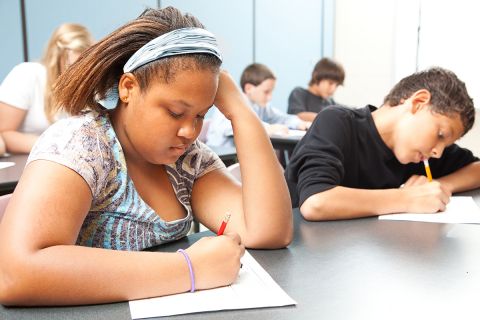Michigan’s student scores fell along with nation’s during COVID-19


Scores in Michigan also declined in fourth-grade math and eighth-grade reading and math, but they were not as dramatic. The falling scores come just three years after Michigan showed marked improvement on NAEP compared with students in other states.
Another cause for alarm: The longstanding gap between low-income students and their more affluent peers widened considerably this year.
Experts say the declines are proof of the impact of the unprecedented disruptions of COVID. Most states banned in-person learning in the spring of the 2019-20 school year and many districts toggled between remote and in-person throughout the 2020-21 school year, with Michigan students learning remotely for long stretches.
Monday’s release of national scores, in which Michigan finished in the middle of the pack, raised concern.
“The results in today’s NAEP…are appalling and unacceptable,” U.S. Secretary of Education Secretary Miguel Cardona said in a press conference.
“They’re a reminder of the impact this pandemic had on our learners and the important work we must do now for our students. This is a moment of truth for education, how we respond to this will determine not only our recovery, but our nation’s standing in the world.”
Cardona called for schools to use research-backed ways to help students recover.
“The data prior to the pandemic did not reflect an education system that was on the right track,” he said. “The pandemic simply made it worse. It took poor performance and dropped it down even further. As an educator and as a parent, that’s heartbreaking. It’s horrible. It’s an urgent call to action.”
The NAEP, given every two years, is a national test drawn from a sampling of schools that allows comparisons among states. Because of the pandemic, the test was delayed last year and given this past spring instead.
In Michigan, 5,000 students took the reading tests (2,500 in both fourth and eighth grade) and 5,300 students took the math test (2,700 in fourth grade and 2,600 in eighth). The National Assessment Governing board, which administers the NAEP, did not immediately release the names of districts that participated in the testing this past spring, making it difficult to determine if the schools involved operated remotely through much of the pandemic.
The results were similar to declines revealed earlier this fall on Michigan’s state standardized test known as the M-STEP. Generally, students scored worse on the M-STEP this year than in 2019, the last time M-STEP was administered before the pandemic.
Overall, Michigan fourth graders’ average scale score ranked 40th in the nation in reading and 35th in math. The state’s eighth graders ranked 23rd in reading and 25th in math.
But individual state rankings can be misleading. In fourth-grade reading, for instance, Massachusetts (with a score of 227) was among 20 states that performed better than the rest of the country. Michigan (212) was clustered in a group of 27 states with middling scores. Three states (West Virginia, Alaska and New Mexico) pulled up the bottom.
“In spite of the extraordinary efforts of staff and students, the pandemic was very disruptive to learning,” State Superintendent Michael Rice said in a statement. “What teachers do daily in classrooms across the state is incredibly important, and disruptions of any sort, let alone those associated with a pandemic, do harm.”
A national reckoning
Michigan’s NAEP declines mirrored much of the country, where many students were sent home and participated in online learning for large portions of 2020 and 2021.
But students’ experiences with remote learning varied widely, illustrating the impact of technology, and the availability of home support, on their performance.
Students taking the NAEP this year filled out a questionnaire asking about their work-from-home experience during COVID. In fourth-grade math, students who performed poorly were more likely to report receiving daily help with schoolwork but less likely to report regular access to a computer or tablet compared to higher-performing students.
There is “pretty conclusive evidence both in Michigan and across the country that students who learn remotely for longer fared worse in terms of achievement growth over both the 2021 school year and those effects lasted into the 21-22 school year,” Katharine Strunk, director of Education Policy Innovation Collaborative at Michigan State University, told Bridge Michigan.
Strunk said it’s important to remember that oftentimes the districts that stayed virtual-only longer were responding to parental and community sentiment as they faced greater health or economic consequences from the pandemic. She said leaders should also be tracking students’ growth, not just the test score captured when they took the NAEP test.
For Michigan fourth-graders, the gap between low-income and more affluent students widened dramatically this year.
In 2019, the average reading scale score for students from low-income families was 206, compared with scores of 232 for the other students, a gap of 26 points. This year, scores for more affluent students declined, though just a little, to 230, while the average scale score for low-income students fell to 198, a drop of 8 points. That increased Michigan’s income achievement gap to 32 points.
Compared to other states, Michigan’s scores were considered roughly equal to the national average in fourth and eighth grades for reading and math.
But students in neighboring states, where students tended to spend more time in the classroom, fared better, with more students considered proficient or better in math. Wisconsin, Ohio and Indiana students performed above the national average in math in both grade levels.
During the pandemic, a greater proportion of Wisconsin, Ohio and Indiana students learned in-person, according to state-by-state data analyzed by Bridge Michigan.
In contrast, Michigan, a local control state, local school districts, usually in partnership with local health departments, made their own decisions on when to go remote, based on COVID case levels at any particular time.
Some districts, including Ann Arbor, Detroit, Flint and Grand Rapids, chose to remain remote for more than half the 2020-21 school year.
But Peggy Carr, commissioner of the National Center for Education Statistics, cautioned against making sweeping generalizations about the effect of remote learning on test scores.
“I want to point out that there’s nothing in this data that says we can draw a straight line between the time spent in remote learning in and of itself and student achievement,” she said. “Remote learning looked very differently” across the country, Carr said, and it’s important to remember “we have massive, comprehensive decline everywhere.”
Subhed: Michigan’s COVID approach
Nonetheless, there were broad differences among states, with Michigan students often far more likely to be learning from home. In January 2021, for instance, 23 percent of Michigan schools were fully in-person, compared to 47 percent in Ohio, 54 percent in Wisconsin and 76 percent in Indiana.
“It’s hard to disaggregate anywhere in the country the effect of remote instruction from the effect of being in these districts that were more impacted by the pandemic,” Strunk said.
Strunk said large, urban districts like Detroit and Flint were closed because of health needs and in response to feedback from families who said they didn’t feel safe sending their kids to school. In the first months of the pandemic, African Americans in Detroit and elsewhere had some of the highest COVID-19 death rates.
Michigan’s scores include some students from Detroit, which participates in NAEP’s study of the largest urban districts in the country. As it has in the past, Detroit’s students scored the lowest in reading and math in both fourth and eighth grades and recorded some of the largest declines among urban districts.
Detroit, the state’s largest district, is also one of the poorest big cities and poverty has long been an important predictor of poor academic performance.



